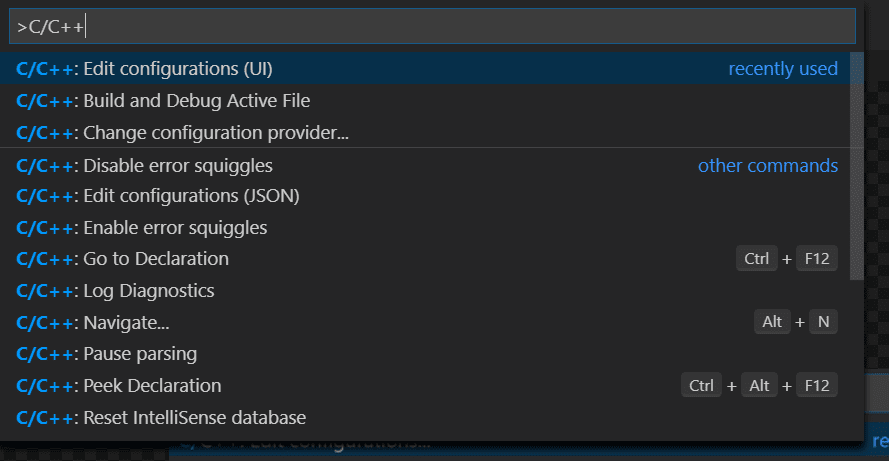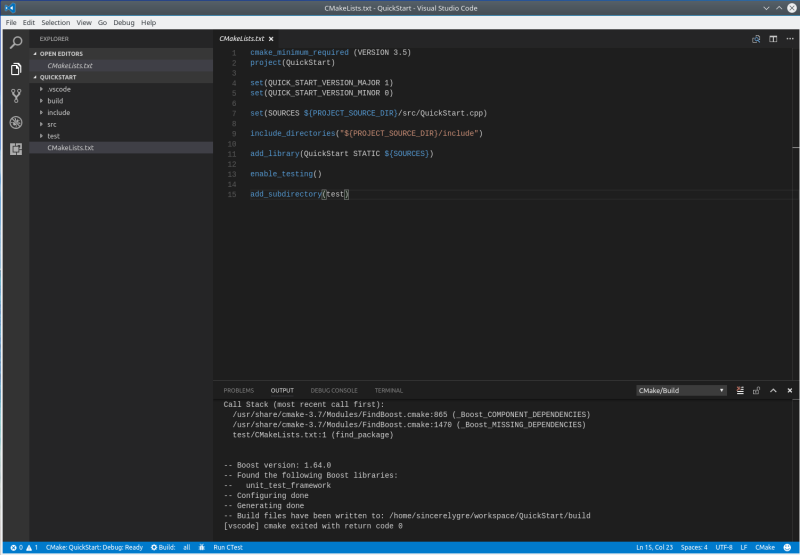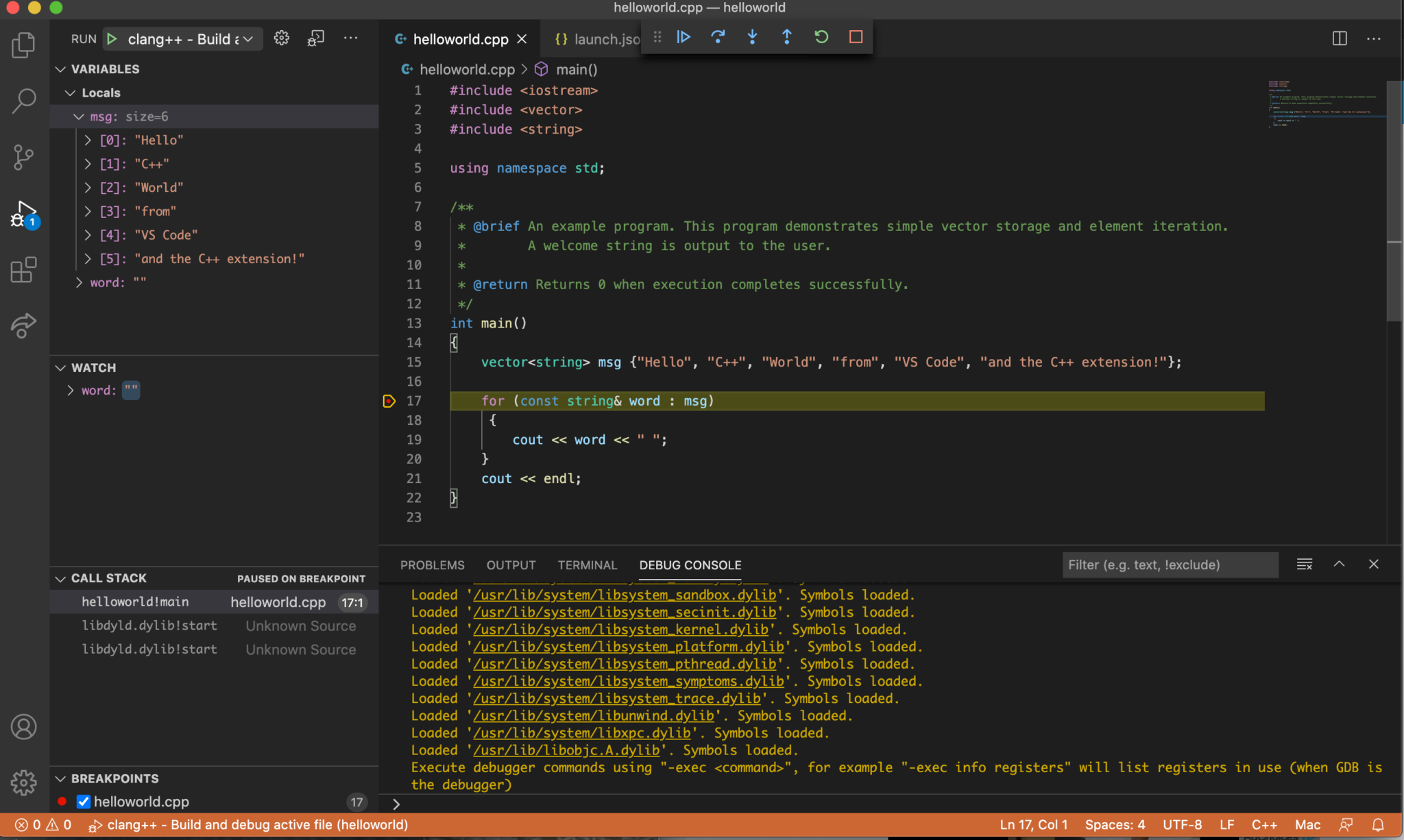PS: This was published on my Blog here.
Let us setup our favourite editor — Visual studio code to have debugging support for c and c projects or files. If you don’t have vscode editor, I suggest downloading it from here and have a. Visual Studio Code is free and available on your favorite platform - Linux, macOS, and Windows. Download Visual Studio Code to experience a redefined code editor, optimized for building and debugging modern web and cloud applications. This section provides a glimpse of what is possible in Visual Studio. To learn more about this area please visit the C Code Editing and Navigation in Visual Studio blog post. One of the most useful features for helping you write code quickly in Visual Studio is IntelliSense, which is a context-aware code completion tool.

C++ is a statically-typed, free-form, (usually) compiled, multi-paradigm, intermediate-level general-purpose middle-level programming language.
In simple terms, C++ is a sophisticated, efficient, general-purpose programming language based on C.
It was developed by Bjarne Stroustrup in 1979.
One of C++'s main features is the compiler. This is used to compile and run C++ code.
A compiler is a special program that processes statements written in a particular programming language like C++ and turns them into machine language or 'code' that a computer's processor uses.
I actually wrote this article because I had a C++ assignment which required using a compiler. As usual, everyone was using the CodeBlocks IDE and Visual Studio IDE. But I was already used to Visual Studio Code for all my programming stuff.
Run C++ Program With Visual Studio Code
I then set out to find a way of compiling C++ directly inside my own VsCode Editor, hence this article :).
In this article, I'll show you how to set up your compiler in VsCode and give you some links to some of the best C++ resources.
- Prior knowledge of C++
(I assume you're learning C++, about to start learning, or just reading this for fun. This article is not a C++ 101 tutorial – some understanding of C++ is needed.) - Visual Studio Code Editor
Download here and read the setup docs for Windows, Linux and Mac - Internet connection (!important)
Disclaimer!
I will be using a Windows OS throughout this article, but I'll provide links to resources that will help those using other operating systems.
Now let's get started!
- Head to www.mingw.org and click the “Download/Installer” link to download the MinGW setup file, or click here for Windows, here for Linux, and here for Mac
MinGW, a contraction of 'Minimalist GNU for Windows', is a minimalist development environment for native Microsoft Windows applications.
- After downloading, install MinGW and wait for the “MinGW Installation Manager” to show up.
- When the “MinGW Installation Manager” shows up, click on
mingw32-gcc-g++then select “Mark for Installation”
- In the menu at the top left corner, click on “Installation > Apply Changes”
- Wait and allow to install completely. Ensure you have a stable internet connection during this process.
PATH is an environment variable on Unix-like operating systems, DOS, OS/2, and Microsoft Windows, specifying a set of directories where executable programs are located. In general, each executing process or user session has its own PATH setting. - Wikipedia
After installing MinGW, it can be found in C:MinGWbin. Now you have to include this directory in your environment variable PATH. If you've been using computers for a while now you should know how to do this already, but if you don't, here are a few resources:
- Click here for a Windows OS guide
- Click here for Linux
- Click here for a Mac OS guide
Now we have our compiler set up, let's install Code Runner
Code Runner allows you to Run code snippet or code file for multiple languages:
C, C++, Java, JavaScript, PHP, Python, Perl, Perl 6, Ruby, Go, Lua, Groovy, PowerShell, BAT/CMD, BASH/SH, F# Script, F# (.NET Core), C# Script, C# (.NET Core), VBScript, TypeScript, CoffeeScript, Scala, Swift, Julia, Crystal, OCaml Script, R, AppleScript, Elixir, Visual Basic .NET, Clojure, Haxe, Objective-C, Rust, Racket, AutoHotkey, AutoIt, Kotlin, Dart, Free Pascal, Haskell, Nim, D, Lisp, Kit, and custom command.
- Click here to download
- Or search in VsCode marketplace tab
- After installing restart VsCode
- Open your C++ file in Vscode. Here's a basic hello world program below:
Save this file as test.cpp
- Use the shortcut
Ctrl+Alt+N - Or press F1 and then select/type Run Code
- Or right-click the Text Editor and then click Run Code in the editor context menu

The code will run and the output will be shown in the Output Window. Open the output window with `Ctrl+ shortcut.
- Use the shortcut
Ctrl+Alt+M - Or press F1 and then select/type Stop Code Run
- Or right-click the Output Channel and then click Stop Code Run in the context menu
Hurray, you just successfully set up your C++ environment in VsCode!
Here's a quick hint: By default, VsCode's output terminal is read-only. If you're running code that requires user input like:
you won't be able to type into the terminal, Cannot edit in read-only terminal.
To fix this, you need to manually enable read-write.
- In VsCode, Go to File > Preference > Setting.
- In the User tab on the left panel, find the extensions section
- Scroll and find 'Run Code Configuration'
- Scroll and find a checkbox
Run in Terminal(Whether to run code in Integrated Terminal) Check the box.
OR
- In your
setting.jsonfile, add:
Hurray, you're done and ready to roll :).
Here are some C++ resources you can use to get started with learning C++
- Code Runner by Jun Han
Thank you for reading!
-->If you haven't downloaded and installed Visual Studio and the Microsoft C/C++ tools yet, here's how to get started.
Visual Studio 2019 Installation
Welcome to Visual Studio 2019! In this version, it's easy to choose and install just the features you need. And because of its reduced minimum footprint, it installs quickly and with less system impact.
Note Nch software mixpad registration code.
This topic applies to installation of Visual Studio on Windows. Visual Studio Code is a lightweight, cross-platform development environment that runs on Windows, Mac, and Linux systems. The Microsoft C/C++ for Visual Studio Code extension supports IntelliSense, debugging, code formatting, auto-completion. Visual Studio for Mac doesn't support Microsoft C++, but does support .NET languages and cross-platform development. For installation instructions, see Install Visual Studio for Mac.

Want to know more about what else is new in this version? See the Visual Studio release notes.
Ready to install? We'll walk you through it, step-by-step.
Step 1 - Make sure your computer is ready for Visual Studio
Before you begin installing Visual Studio:

Check the system requirements. These requirements help you know whether your computer supports Visual Studio 2019.
Apply the latest Windows updates. These updates ensure that your computer has both the latest security updates and the required system components for Visual Studio.
Reboot. The reboot ensures that any pending installs or updates don't hinder the Visual Studio install.
Free up space. Remove unneeded files and applications from your %SystemDrive% by, for example, running the Disk Cleanup app.
Cellebrite ufed physical analyzer crack. For questions about running previous versions of Visual Studio side by side with Visual Studio 2019, see the Visual Studio 2019 Platform Targeting and Compatibility page.
Step 2 - Download Visual Studio
Next, download the Visual Studio bootstrapper file. To do so, choose the following button to go to the Visual Studio download page. Select the edition of Visual Studio that you want and choose the Free trial or Free download button.
Step 3 - Install the Visual Studio installer
Run the bootstrapper file you downloaded to install the Visual Studio Installer. This new lightweight installer includes everything you need to both install and customize Visual Studio.
From your Downloads folder, double-click the bootstrapper that matches or is similar to one of the following files:
- vs_community.exe for Visual Studio Community
- vs_professional.exe for Visual Studio Professional
- vs_enterprise.exe for Visual Studio Enterprise
If you receive a User Account Control notice, choose Yes to allow the bootstrapper to run.
We'll ask you to acknowledge the Microsoft License Terms and the Microsoft Privacy Statement. Choose Continue.
Step 4 - Choose workloads
After the installer is installed, you can use it to customize your installation by selecting the workloads, or feature sets, that you want. Here's how.
Find the workload you want in the Installing Visual Studio screen.
For core C and C++ support, choose the 'Desktop development with C++' workload. It comes with the default core editor, which includes basic code editing support for over 20 languages, the ability to open and edit code from any folder without requiring a project, and integrated source code control.
Additional workloads support other kinds of development. For example, choose the 'Universal Windows Platform development' workload to create apps that use the Windows Runtime for the Microsoft Store. Choose 'Game development with C++' to create games that use DirectX, Unreal, and Cocos2d. Choose 'Linux development with C++' to target Linux platforms, including IoT development.
The Installation details pane lists the included and optional components installed by each workload. You can select or deselect optional components in this list. For example, to support development by using the Visual Studio 2017 or 2015 compiler toolsets, choose the MSVC v141 or MSVC v140 optional components. You can add support for MFC, the experimental Modules language extension, IncrediBuild, and more.
After you choose the workload(s) and optional components you want, choose Install.
Next, status screens appear that show the progress of your Visual Studio installation.
Tip
At any time after installation, you can install workloads or components that you didn't install initially. If you have Visual Studio open, go to Tools > Get Tools and Features.. which opens the Visual Studio Installer. Or, open Visual Studio Installer from the Start menu. From there, you can choose the workloads or components that you wish to install. Then, choose Modify. Cat mario 3 download pc.
Step 5 - Choose individual components (Optional)
If you don't want to use the Workloads feature to customize your Visual Studio installation, or you want to add more components than a workload installs, you can do so by installing or adding individual components from the Individual components tab. Choose what you want, and then follow the prompts.
Step 6 - Install language packs (Optional)
By default, the installer program tries to match the language of the operating system when it runs for the first time. To install Visual Studio in a language of your choosing, choose the Language packs tab from the Visual Studio Installer, and then follow the prompts.
Change the installer language from the command line

Another way that you can change the default language is by running the installer from the command line. For example, you can force the installer to run in English by using the following command: vs_installer.exe --locale en-US. The installer will remember this setting when it's run the next time. The installer supports the following language tokens: zh-cn, zh-tw, cs-cz, en-us, es-es, fr-fr, de-de, it-it, ja-jp, ko-kr, pl-pl, pt-br, ru-ru, and tr-tr.
Step 7 - Change the installation location (Optional)
You can reduce the installation footprint of Visual Studio on your system drive. You can choose to move the download cache, shared components, SDKs, and tools to different drives, and keep Visual Studio on the drive that runs it the fastest.
Important
You can select a different drive only when you first install Visual Studio. If you've already installed it and want to change drives, you must uninstall Visual Studio and then reinstall it.
Step 8 - Start developing
After Visual Studio installation is complete, choose the Launch button to get started developing with Visual Studio.
On the start window, choose Create a new project.
In the search box, enter the type of app you want to create to see a list of available templates. The list of templates depends on the workload(s) that you chose during installation. To see different templates, choose different workloads.
You can also filter your search for a specific programming language by using the Language drop-down list. You can filter by using the Platform list and the Project type list, too.
Visual Studio opens your new project, and you're ready to code!
Visual Studio 2017 Installation
In Visual Studio 2017, it's easy to choose and install just the features you need. And because of its reduced minimum footprint, it installs quickly and with less system impact.
Prerequisites
C++ Development With Visual Studio Code
A broadband internet connection. The Visual Studio installer can download several gigabytes of data.
A computer that runs Microsoft Windows 7 or later versions. We recommend Windows 10 for the best development experience. Make sure that the latest updates are applied to your system before you install Visual Studio.
Enough free disk space. Visual Studio requires at least 7 GB of disk space, and can take 50 GB or more if many common options are installed. We recommend you install it on your C: drive.
For details on the disk space and operating system requirements, see Visual Studio Product Family System Requirements. The installer reports how much disk space is required for the options you select.
Download and install
To download the latest Visual Studio 2017 installer for Windows, go to the Microsoft Visual Studio Older downloads page. Expand the 2017 section, and choose the Download button.
Tip
The Community edition is for individual developers, classroom learning, academic research, and open source development. For other uses, install Visual Studio 2017 Professional or Visual Studio 2017 Enterprise.
Find the installer file you downloaded and run it. The downloaded file may be displayed in your browser, or you may find it in your Downloads folder. The installer needs Administrator privileges to run. You may see a User Account Control dialog asking you to give permission to let the installer make changes to your system; choose Yes. If you're having trouble, find the downloaded file in File Explorer, right-click on the installer icon, and choose Run as Administrator from the context menu.
The installer presents you with a list of workloads, which are groups of related options for specific development areas. Support for C++ is now part of optional workloads that aren't installed by default.
For C and C++, select the Desktop development with C++ workload and then choose Install.
When the installation completes, choose the Launch button to start Visual Studio.
The first time you run Visual Studio, you're asked to sign in with a Microsoft Account. If you don't have one, you can create one for free. You must also choose a theme. Don't worry, you can change it later if you want to.
It may take Visual Studio several minutes to get ready for use the first time you run it. Here's what it looks like in a quick time-lapse:
Visual Studio starts much faster when you run it again.
When Visual Studio opens, check to see if the flag icon in the title bar is highlighted:
If it's highlighted, select it to open the Notifications window. If there are any updates available for Visual Studio, we recommend you install them now. Once the installation is complete, restart Visual Studio.
Visual Studio 2015 Installation
To install Visual Studio 2015, go to the Microsoft Visual Studio Older downloads page. Expand the 2015 section, and choose the Download button. Run the downloaded setup program and choose Custom installation and then choose the C++ component. To add C and C++ support to an existing Visual Studio 2015 installation, click on the Windows Start button and type Add Remove Programs. Open the program from the results list and then find your Visual Studio 2015 installation in the list of installed programs. Double-click it, then choose Modify and select the Visual C++ components to install.
In general, we highly recommend that you use the latest version of Visual Studio even if you need to compile your code using the Visual Studio 2015 compiler. For more information, see Use native multi-targeting in Visual Studio to build old projects.
Visual Studio Code For Beginners
When Visual Studio is running, you're ready to continue to the next step.
C Programming With Visual Studio Code
Next Steps
